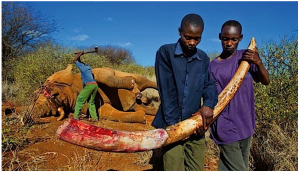Beginning in 1979, the demand for ivory around the world caused the elephant populations to decrease drastically. There were about 1.3 million elephants in Africa in 1977 and the population decreased to about 600,000 by 1997. There are approximately 470,000 African elephants left in the wild today. There was an estimated 100,000 elephants being killed each year during the 80’s. A ban on international trade was introduced in 1989 which has helped some populations recover, but there are still tens of thousands of elephants being poached every year for their tusks. Below is a video of Thailand seizing three tons of elephant tusks that were being sold for their ivory.
https://www.youtube.com/watch?v=ZIHOeWyGwdo
Would there be a way we could stop humans from butchering these animals for their tusks? While it is a longshot, there has been the idea of an orally taken dye treat that would stain the tusks of the elephant. This would not harm the elephant in any way. It would only stain their tusks to a different color which would make them invaluable to humans. While distribution of this to every single elephant would be nearly impossible, it could save many of their lives and possibly help increase their dwindling population.

—Brent Stirton, Getty Images/National Geographic
The elephant’s tusks are very large and permeable, so it could be hard to create something that would have that type of effect on them. As pictured above, a third of the tusk’s length is hidden inside of the elephants head and they can grow up to 11 feet in length and 220 pounds. The dye would have to be able to penetrate through the dentin of the tusk. It must also be able to leave the colorblind animal oblivious to the fact that they have changed colors. It would need to be visible to the naked eye and be able to stain new tusk growth.
https://fightforrhinos.files.wordpress.com/2013/03/pink-dyed-tusks
While the elephant in this photo is photo shopped, it gives you an idea of what it would look like. While such tablet has not been created yet, the idea is circulating. I can only hope it will reach the right person that can make this a reality. We need to do something about the decreasing population before it is too late.
-Ashley Overstreet
http://www.pbs.org/wnet/nature/elephants-africa-poaching-problem/11367/
http://wwf.panda.org/what_we_do/endangered_species/elephants/african_elephants/

